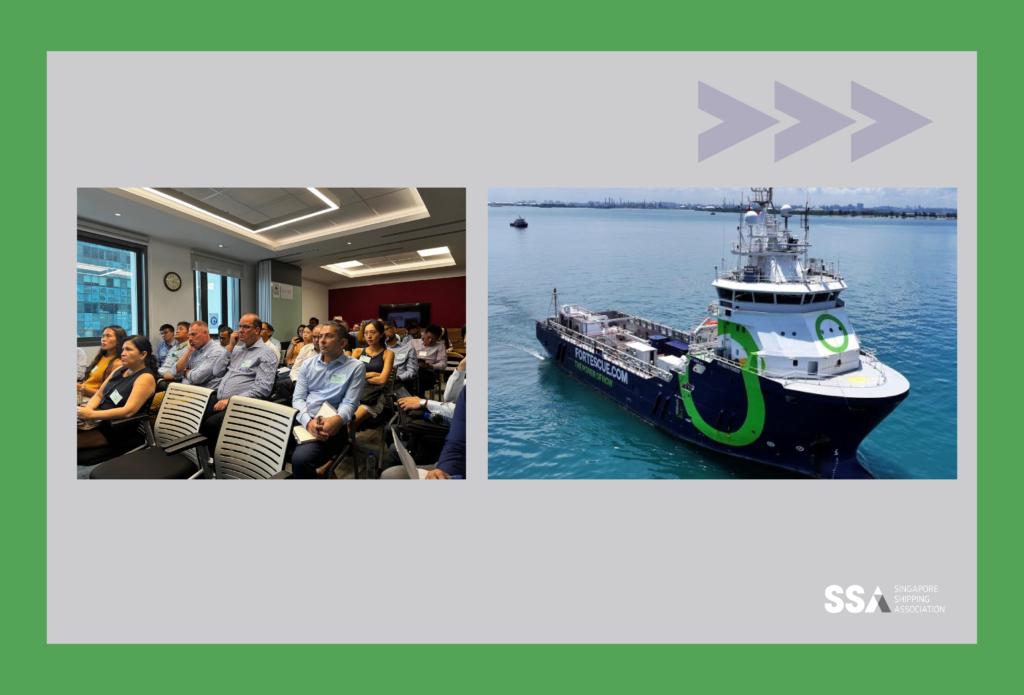
On 22nd of April 2024, we welcomed over 40 participants from our member companies at our office for an insightful session titled “Navigating the Sustainability of Shipping with Ammonia” where distinguished speakers explored key topics such as the viability of ammonia as a sustainable fuel, bunkering challenges and best practices, as well as crew training.
“Unlike other talks on bunkering, which usually focus more on the equipment and emissions aspect of ammonia, this talk will focus more on the human aspect,” said Joey Ng, Marine Strategy & Development, Fortescue.
He was who was one of three distinguished speakers who also include the Chair of Marine Fuels Committee, Mr Apostolos Boutos and Andrew Hoare, Global Head of Shipping and Marine Projects, Fortescue. The guests from Fortescue shared learnings from Singapore’s First Use of Ammonia as a Marine Fuel onboard Fortescue Green Pioneer.
The Singapore-flagged ammonia-powered Fortescue Green Pioneer played a starring role in Singapore’s historic first transfer of ammonia for marine fuel. Singapore made history in March 2024 when the Green Pioneer took on liquid ammonia at the Vopak Banyan Terminal on Jurong Island. This wasn’t just any refuelling – it marked the first-time ammonia was used as a marine fuel in a real-world scenario. This transfer is a big step towards cleaner and greener shipping.
Crew Training is Paramount
“The biggest problem Fortescue faced was in moving ahead even without IMO regulation,” Joey explained. “In the space where there is no regulation, confidence has to be proven, most importantly”. He said that about 10 crew were trained for about a week and half before the pilot operation, where they went through a multitude of courses to build their capabilities in handling ammonia.
Safety Protocols Tailored for Ammonia
“With limited resources on the ship, Fortescue had to build safety protocols around the crew,” Joey continued. “Different safety protocols have to be developed for the different challenges. Feedback was gotten from the crew on what was easy and difficult, and safety protocols were right-sized based on the feedback given, to optimise the time, people and resources. This is very different from conventional safety which is just layering on more safety. When there is a problem and it cannot be isolated, then evacuation has to take place. With a total loss of containment, one would need to abandon ship,” Joey explained. “Investigation will take place after everything has been isolated.”
Non-Linear Approach to Safety
Ammonia is being used onshore and on vessel and there is a lot of literature behind it. There are three key things to know about ammonia when dealing with it as a chemical, the first is ppm which is concentration, the second is volume and the third is time. When building safety protocols, it is a series of non-linear events that can change in position in anyway, and the axis of ppm, axis of volume and axis of time have to be considered which will then change the solutions as we go along. Hence, when we work on safety protocols, what may work on the highest possible level may not work on the lowest possible level and a rundown of resources is needed to be gone through as different events is gone through.
Containment Measures and Refuge Procedures for Ammonia Spills
Lastly, a topic in the session that was covered was on how containers on board vessels are dealt with. A lot of water is used onboard the ship to keep ammonia in and ammonia out. When there is a loss of deployment, the first thing is to deploy a curtain of water and ammonia will be kept in. Refuge and safe heavens are important when talking about ammonia, same for hydrogen and methanol.
We hope participants had a fruitful session and the SSA looks forward to hosting more technical sessions in future to foster collaboration and knowledge sharing within the maritime industry as it transitions towards a sustainable future.
“In the space where there is no regulation, confidence has to be proven, most importantly.”
Joey Ng, Marine Strategy & Development, Fortescue